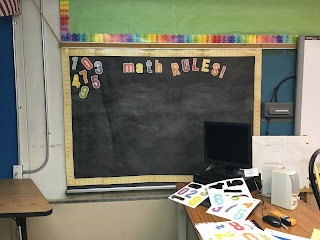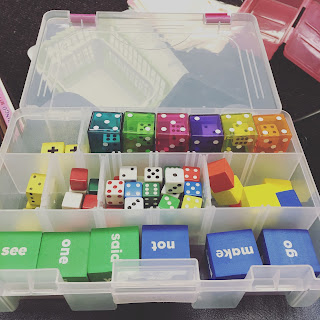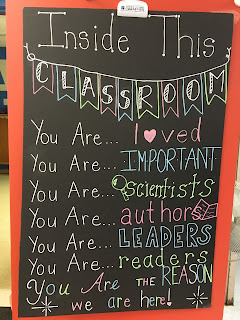This is D.E.A.R. ( Drop Everything And Read) time in my Kindergarten classroom. Fifteen minutes of absolute silent reading time. If you visit the room during this time, you'll notice most of the lights are off, slow jazz is playing in the background, and students are scattered throughout the room lying on the floor, sitting at a desk, or curled up in the library. Though Kindergartners often ask "what's coming next?," "how long until snack time?," or "is it time to go home?,"throughout the day, when they enter our room again after recess- they rarely say a word. Their "you time," as I refer to D.E.A.R., has begun.
So how can we, as educators who see the value in learning and reading and the connection between the two, help to develop this love of reading in all of our youngest learners?
ONE.
The first step to fostering a love of reading is to love reading y o u r s e l f. Emanate the love of reading through your pores. "To love reading" doesn't mean you need to love all novels, or Shakespeare, or sports articles. Love the act of reading and what it can bring to you and your life. Find out which topics and genres inspire you. Bring up your personal reading frequently with your students. Explain how you found a new recipe and it led you to the best gumbo you've ever made. Share with them the instruction manual for a new class game over the document camera. Read them a passage from a novel you're reading with all the passion and expression you can muster. You may even find that you develop a new genre interest yourself!
This is so important because may times students don't remember what you say, but they do remember what you do. You could explain the importance of reading a million different ways but watching you, students will see your engagement, passion, and purpose. Watching you may be the reason your students are motivated to read or, they may simply copy you and fall in love by accident.
TWO.
Give them time to share about their reading experiences. Too often, we rush from one subject of the day to another. Though we may try, it is so difficult to conclude each lesson with a review or discussion of what was learned. But reading is never to be rushed. Reading, by definition, is the act of making sense of written text. In order to make the most sense out of a written text, we need to be able to understand, make connections, and infer. These strategies for understanding do not develop as a result of pure reading speed; they emerge under fluent reading. Fluent reading is reading at about a conversational pace. Any faster and meaning begins to be impaired. Any slower, and meaning also becomes impaired.
After engaging in any kind of reading activity, students should be prompted to share in a conversational environment. Maybe a turn and talk with friends about the book they found. Maybe sharing whole group about their personal favorite part. Or simply a thumbs up or thumbs down and having a discussion on how it is okay to dislike some books. Discussion leads to drawing conclusions which leads to thinking about reading. This thinking about reading helps the young reader to discover and take the time to figure out what he or she likes, doesn't like, and needs to explore more of. It sets the stage for reading as being a thoughtful activity- not just a 20 minute daily chore.
THREE.
Introduce your students to new genres, types, and series of texts. Have many different types available in your classroom library always, but also pick personalized books for your students. Make a list of the students and a place for their interests to be recorded. Once you make this list, it will be easier to provide some books directly specified for them. Books that are catered towards the interests of your students not only entice them to pick up the book, but also take away some anxiety about the difficulty of reading. Every once and a while, throw a book in a student's bin that deviates from their interests to introduce a new genre or topic.
Each classroom should include a student-friendly library with all books available to all readers all year round. The idea of a classroom library isn't to remind students of their reading level or to push them to read a level higher than they are currently- but it is to grow a love of reading. Fountas and Pinnell share this opinion as they deem that reading levels are for guided reading groups and are not meant to bind a reader to a certain set of books.
The books included in your library should be in a range of topics, lengths, and genres. They should be organized in a meaningful way that is appropriate to the age of the students (for example character bins versus by author's last name for the younger students). Lastly, the books should be the responsibility of the students. They should be taught where each book belongs and where it doesn't and expected to treat each book as such.
FOUR.
Set not just the mood, but create an entire reading environment. Reading takes concentration. Even before students can read actual words, we can enhance their concentration skills by focusing on the pictures and story line and by ensuring they are in a conducive environment. We tend to read to our children in a quiet bedroom when we are comfortable and focused. Or on the couch with blankets and snacks on a rainy afternoon. Reading takes focus and requires minimal distractions. Otherwise, it is too difficult to focus and the meaning of the text falls apart, leading to inattention or "boredom."
We, as teachers, are asked to fit so much into our daily lessons that we may just barely squeeze in some time for free choice, quiet reading. Many teachers of younger elementary grades avoid it completely, deeming it ineffective if the students cannot read yet or are only early readers. But we must remember that reading begins before the reader can read alone. It includes story telling, pictures, book handling, and sense making. Any child can enjoy the act of reading.
So create a reading environment and watch how effective it really is!
Our reading environment looks like this:
1. dim lights
2. total silence (I don't do reading buddy peers at this time - it is their "me time")
3. light jazz music in the background
4. flexible seating
5. reading buddies (stuffed animals)
6. a teacher who is reading, too ♡
FIVE.
One of the best ways to encourage and grow a love of reading is to story tell. All different cultures and peoples have told stories for centuries. Some cultures still feel uncomfortable writing down their ideas and tales for fear that they will diminish in value. Some Native American peoples still hold this belief today. The idea is poignant: writing things down, while allowing the story to reach a larger audience, frees the author of remembering each and every detail of the idea or event. The story no longer needs to be rehearsed in the author's mind and is no longer part of their every day. A different atmosphere is created when stories are told aloud. It takes away the need for reading skills and requires a complete focus on the plot and emotion of the story so as to engage the audience without pictures.
Twice a week, on Tuesdays and Thursdays, we begin writing block with story telling. A few children per day sit in my rocking chair and share a complete story of their choice. It can be a personal narrative, made up fiction, or a non-fiction informational story. This activity grows their love of the story. Their knowledge of story parts. Their understanding of characters. Above all, it allows them to develop their interests and watch the emotions of their peers. Story telling allows children to fall in love with the story line and the excitement of the plot so that when they begin the difficult task of reading... they are already motivated by the promise of a good story.
SIX.
Maybe the most crucial step to take in developing lifelong readers is to read with your students. Not to them, not shared with them, but next to them. This past summer, I listened to a few of my teacher friends complaining about how they were supposed to get their young elementary and even Kindergarten students to read to themselves quietly. Though I also loved the idea of a peaceful and productive D.E.A.R. time, it often was loud, unruly and unproductive. After all, how could I expect these young children who are full of energy and can barely read to enjoy 15 minutes of quiet "reading?"
Just like any other skill children need to learn, we must teach our children how to be a reader. I don't mean how to read. How to be a reader. And just like any other skill, we must do as we say and say as we do. Children copy our behaviors. I found this to be true for reading when one afternoon, I was overwhelmed (imagine?!) and needed to use the children's D.E.A.R. time to review an article for an after school meeting. I sat in the rocking chair, among my Kindergartners who were sprawled across the floor, and began reading. Within two minutes, I had a student come up to me to ask what I was doing. Why I was reading it. What it was about. Whether or not I liked it. Then, she returned to her book, grabbed it, and brought it next to me. She, and soon a few other students, read alongside of me for the remainder of the D.E.A.R. time. I, however, could not focus because I noticed the power of my teacher presence. It's as if the students thought: Oh, it's not just "good for me," its good for everyone.
Every single day, I read alongside my students for 15 minutes.
I believe in simplicity.
Waiting to master each subset phonics skill and following a particular reading procedure each time you pick up a book is difficult for students AND teachers to follow. It creates an anxious and tense environment where reading is considered more systematic than enjoyable. Becoming a lifelong reader begins and ends with loving reading. It is not only based on phonics skills. Just as we cannot teach a classroom full of disconnected and anxious students, we cannot expect lifelong readers to come solely from timed readings, DIBELS testing, and teacher-chosen passages; as these are things disconnected from the heart and mind. Engage your students' hearts and minds and you've created the most important foundation for life-long reading.


























































